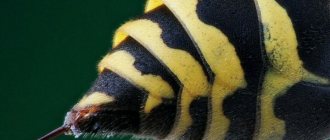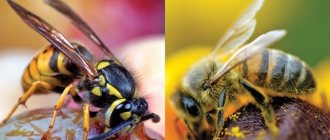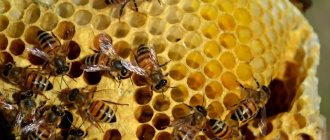Blog articles Beekeeping
Beekeeping
Economics of beekeeping
Beekeeping news in Russia
Beekeeping news in the world
Honey
Propolis
Bee bread
Zabrus
Royal jelly
In the world about bees
Apiary
Bees
News from honey fairs
From the history of beekeeping
- What you need to know about bee stings
- Bee venom: its components and their properties on humans
- Symptoms and consequences of a bee sting
- Providing first aid for bee stings for adults and children
- When medical help is needed
- Folk first aid remedies after a bee sting
- What not to do when helping with a bee sting
Bee stings are the natural protection of bees from enemies
Bees pollinate many plants, produce honey, and valuable medicines are obtained from the waste products of these insects. But it’s not for nothing that they say: “Eat honey, but be afraid of the sting.” Bee stings are not only very painful, but in some exceptional cases they can even lead to death.
For the sake of fairness, it should be noted that a bee stings only when it is forced to defend itself, because after losing its sting weapon, it dies. The bee has a sharp, hollow stinger with jagged ends, through which poison is injected into the blood of the victim. Since the sting, along with the poisonous capsule, remains in the body of the bitten person and goes deeper into the wound, this contributes to its spread throughout the body.
Most often, single stings are not dangerous to humans, but multiple stings can cause general intoxication of the body. That is why safety precautions play a huge role in beekeeping. The beekeeper always wears protective clothing when going to the hives. It is the composition of the poison that causes burning and inflammation, causing allergic reactions. In winter, the toxic properties of the poison are much weaker than in the warm period. Worker bees aged 7 to 20 days are considered the most poisonous.
Essential Information About Bee Stings
To understand how to act correctly, you need to know the following. The bee's sting is connected to a special reservoir in the bee's abdomen containing venom. When bitten, the serrated sting usually gets stuck in the skin and breaks off. Often, along with the sting, a sac with poison attached to it remains, and the poison continues to enter the bloodstream even after direct contact with the bee has been interrupted. That is why it is necessary to remove the sting from the wound, do it quickly and very carefully, so as not to inject the poison from the sac into the bite site.
Bee venom has an acidic reaction (unlike wasp venom, which has an alkaline reaction), so alkalis - liquid soap, soap solution, baking soda solution - help neutralize it.
Bee venom: its components and their properties on humans
Bee venom or, as it is also called, apitoxin is produced by worker bees. It is a thick transparent liquid with a slight odor of honey and a bitter taste. Apitoxin has a very complex composition and has a strong active effect. The poison contains not only proteins and amino acids, but also fat-like and mineral substances. It consists of 50% water.
The main dry element of apitoxin is melitin and other toxic polypeptides, which, interacting with organic acids, magnesium and proteins with enzymatic properties (phospholipase A2, hyaluronidase, acid phosphatase) make it therapeutic. Hyaluronidase, for example, promotes the rapid spread of apitoxin, and phospholipase A2 reduces blood clotting. But histamine, which is part of apitoxin, causes swelling of the tissue in the bitten area and is the main cause of anaphylactic shock, but at the same time, thanks to it, apitoxin helps reduce blood pressure and dilates blood vessels.
Bee venom contains the following amino acids:
- alanine;
- isoleucine;
- arginine;
- cystine;
- glycine;
- tryptophan.
Also, minerals such as manganese, sulfur, phosphorus, iodine and others were found in it. The sting causes a strong burning sensation due to the acids (formic, phosphoric, hydrochloric) included in its composition. The effect of poison on a person depends not only on its amount entering the blood, but also on the place of penetration and individual intolerance.
What happens next
After a bite, metabolism in the cells improves. The vessels dilate, blood flows to the organ. Fluid is retained in the tissues, and swelling gradually increases. Acute pain is observed only in the first hours, but the increase in local temperature and redness lasts up to several days.
In the first 12 hours, erectile dysfunction is possible due to pain, but when the discomfort subsides, having sex becomes quite possible.
How long does a penis get enlarged after a bee sting?
It all depends on the individual characteristics of the body. On average, the swelling will last only two to three days. At the same time, oddly enough, the answer to the question of whether it is possible to enlarge the penis with bee stings for a long period has a positive answer. If you regularly use bee venom, the body gradually gets used to its toxic components. The dose can be increased, and not just one bee sting on the penis can be used, but several at once.
The poison will improve blood condition and reduce cholesterol. Due to the frequent increase in this indicator, plaques appear on the walls of blood vessels, as a result of which the organ’s filling with blood is insufficient, and this, in turn, weakens the erection.
Improving metabolism will lead to greater division of healthy tissue cells, which means a slight increase in the size of the organ. True, you shouldn’t place too much hope on a bee sting on your penis. Natural heredity will take its toll.
Bee sting: symptoms and consequences
The very first thing a bitten person feels is a burning sensation and severe pain at the site of penetration. After one or two minutes it swells and turns red. If you look closely, you will see a small black sting on the body, which must be removed. Usually these symptoms gradually decrease, and after three to four days they completely disappear. Approximately 80% of people can safely tolerate up to 5 simultaneous stings without serious consequences. 19% of people may have:
- malaise;
- weakness;
- dizziness and headache;
- low-grade fever;
- hives.
In some people who are stung and if a large amount of toxic substances enters the blood, these symptoms may include diarrhea, severe vomiting, low blood pressure, breathing problems, and convulsions. Sometimes, especially if the attack was in the facial area, hearing loss is observed. And only in 1% of people, a bite, even a single one, can lead to anaphylactic shock. The most dangerous are stings in the neck, eyes, face, and tongue. Typically, allergic manifestations occur fairly quickly within approximately 5-10 minutes. The speed of allergy development and intensity depends on how often bees have bitten before.
How can a bee help with penis enlargement?
Even in the times of Galen and Hippocrates, men used bee venom to improve potency and erection. What happens if an insect bites painfully on the genitals?
Venom is given to the bee by nature to protect its hive from the enemy. Ancient physicians were well aware of its anti-inflammatory properties.
Bee venom was used especially extensively to treat radiculitis and the nervous system.
As time shows, bee venom has stood the test of centuries. Its effectiveness has long been proven by the world's leading scientists. The poison is highly soluble in water and biological fluids. In air, the substance quickly takes on a solid form.
The composition of bee venom was discovered 50 years ago. Its main ingredient is melittin. This component reduces blood clotting and activates blood flow. In the last century, scientists isolated a certain polypeptide with strong activity from bee venom. It was also found that bee venom has a beneficial effect on vascular walls.
First of all, it is necessary to understand that bee venom has many medicinal properties.
The substance catalyzes biochemical processes in the human body, strengthens defenses and eliminates disease.
It is noteworthy that many ointments intended for penis enlargement contain bee venom. The substance also helps get rid of:
- prostatitis;
- prostate adenomas;
- erectile dysfunction.
Of course, apitherapy must be used wisely. Before you start, you need to make sure that there is no allergic reaction to bee products and bee venom. Apitherapy should be carried out under the supervision of a specialist.
What are the properties of bee venom? At its core, it is a powerful antiseptic of natural origin. It kills pathogenic microflora and stops the inflammatory process.
Bee venom released from an insect bite:
- ensures rapid blood flow to the genital organ;
- restores erection;
- thins blood masses;
- dilates blood vessels and cavernous bodies of the organ.
Enlargement of the penis under the influence of bee stings occurs gradually. In this case, the effect of bee venom should be carried out in the desired area of the phallus. Due to the expansion of the corpora cavernosa, a long-lasting and persistent erection occurs.
Providing first aid to adults and children
The most important thing to do after being bitten by a bee is to quickly remove the sting. Usually it does not go deep and therefore it is quite easy to pull it out. To do this, you should use tweezers; if you don’t have them at hand, you should carefully grab the sting with clean nails. If it breaks off and a piece remains in the wound, then you can remove it using a thin needle (pin), having previously disinfected them. After this, you need to disinfect the wound with an antiseptic solution or wash it with water and laundry soap.
To reduce itching and burning, apply a cotton swab soaked in ammonia or salt solution to the wound. A cold compress will help relieve swelling and stop the spread of apitoxin. Place a piece of ice wrapped in a cloth, a heating pad filled with cold water, or just a towel soaked in water on the wound. The main thing is that the objects applied to the stung area are clean, otherwise infection may occur. To remove toxic components from the body as quickly as possible, you should drink plenty of fluids.
If a person is prone to allergies, then he should take an antihistamine as a preventative measure. If a severe form of allergy develops, the person who has been bitten must be put down, wrapped warmly, urgently call a doctor, or taken to the hospital as soon as possible.
Sequencing
Those who are too susceptible to pain, excessively fearful and nervous should not start, because unpleasant sensations cannot be avoided. If you are determined to achieve results, get started.
- The penis and hands must be clean.
- The bee must be picked up carefully so that it does not sting your fingers.
- Examine the organ, select the location of the bite at the base of the penis or along the length of the shaft. Point the bee belly down and press down.
- When you feel pain, do not pull your hand away; it is important that the poison has time to get under the skin.
- Do not immediately remove the sting; wait five minutes until all the toxic substances come out of it. The insect will die, so it cannot be reused.
- The antiseptic will burn sensitive skin, therefore, it is enough to wash the perineum with soap and water.
- Stroking movements with your palm with light pressure will help the poison disperse through the tissues faster.
- After 10 minutes, the poison takes effect, and the penis begins to visibly increase in size.
Video: First aid for a bee or wasp sting
If a bee has bitten a child, first aid is provided in the same way as for an adult. To treat a wound, you should not use alcohol-containing antiseptics, but rather use hydrogen peroxide or soapy water. To prevent an allergic reaction, it is recommended to give a child under 10 years of age an antihistamine or treat the damaged area with an antiallergic cream.
Finding the location of the lesion
If a child is bitten by a bee, a sting always remains in the dermis. The longer it lingers, the more poison will be released, and the more painful and prolonged the inflammatory process will be.
Therefore, you need to try to remove the sting and poison in any way possible. First aid is about speed, not method.
Wasps never leave a sting, but they can attack multiple times. This means that if you don't see the stinger, it was probably never there. But they can also cause an anaphylactic reaction, especially if the wasp stings several times.
When medical help is needed
Most often, after providing first aid for a bee sting, a person does not need to see a doctor, but sometimes this cannot be avoided. You must immediately call an ambulance or take the person bitten to the hospital if:
- loss of consciousness;
- spread of allergic rash;
- rapidly increasing swelling;
- respiratory arrest;
- beginning shortness of breath;
- strong heartbeat;
- convulsions;
- in case of vomiting;
- attack and bites of more than 15 insects (child, elderly people, pregnant women more than 5).
Possible complications
The consequences of bee vinegar can be disastrous. Insect venom for enlarging the penis is strictly prohibited if there is hypersensitivity to the main component.
This is why it is so important to carry out the procedure only with a specialist. As described above, first you need to check your body’s reaction to allergies. To do this, you can place a bee on your hand and wait for it to bite.
The main symptoms of an allergic reaction, in which penis enlargement using this method is prohibited:
- redness and swelling of the skin;
- difficulty breathing;
- chills;
- temperature rise;
- difficulty swallowing saliva;
- weakness and dizziness.
Bee venom is the strongest allergen. It can cause anaphylactic shock (asphyxiation), which can result in human death.
Therefore, if a bee stings your penis, and after that allergic reactions begin, you should immediately take an antihistamine (for example, Suprastin).
Folk first aid remedies
There are many folk remedies that help provide first aid for a bee sting. All of them are as effective as medications, but they are allowed to be used only after the sting has been removed and if the person is not allergic to bee waste products. An ordinary coltsfoot leaf applied to the inflamed skin with the cold side reduces pain and relieves swelling. Burdock and plantain leaves have exactly the same properties. It is recommended to use a validol tablet as a cooling agent, which should be applied to the bitten area as soon as possible.
To disinfect the affected area, it is recommended to treat the affected area with garlic or onion juice, but since the juices of these plants can cause burns and severe irritation, it is not recommended for the child to treat the penetration site with them. It is also good to squeeze dandelion or parsley juice onto the wound to relieve pain. To reduce irritation and burning, the skin is lubricated with vegetable oil, preferably olive oil.
Soda solution also relieves itching well; it needs to be used to lubricate the redness every 20 minutes. If you don’t have any antihistamines in your medicine cabinet, you can dissolve an aspirin and activated charcoal tablet in 50 ml of warm water, moisten a bandage and apply it to the bitten area.
Pros and cons of apitherapy
Apitherapy is an unconventional method of treating many diseases.
It is based on the healing effects of bee venom on the organic structures of the human body. The method of treatment with bees is especially effective for patients with radiculitis, infertility, and ailments of the genitourinary system.
The treatment is similar to leech therapy, but bees are used instead. The insect stings for less than one minute and injects its poison into organic tissue. The method cannot use a large number of bees. Otherwise, anaphylactic shock may develop.
If at the beginning of the procedures it seems painful and unpleasant sensations arise, then in the further process of treatment the human body gets used to bee stings. Today, the modern pharmacological industry widely uses bee venom as the main component of many medicines.
After several apitherapy procedures, doctors diagnose a significant improvement in health and elimination of symptoms of various diseases.
If a person is not afraid of short-term pain and is focused on obtaining a positive result, then he may well take bees as assistants to improve his health.
Apitherapy is especially useful for men. Many representatives of the stronger sex place bees directly on the genitals to ensure a stable and long-lasting erection. Healing insect bites also help improve potency and increase penis size.
- Not all men are happy with the size of their penis...;
- Read here about penis stretching;
- Hanging a load to increase: .
Tips for allergy sufferers
It is believed that there are few people in whom a wasp or bee sting can cause such a strong and life-threatening reaction - approximately 2 or 3%. But if you know you are prone to allergic reactions, when going outdoors, take antihistamines with you.
The general first steps after a wasp or bee sting include applying a tourniquet above the bite site. To prevent a decrease in blood pressure caused by urticaria, the victim can be given 25 drops of cordiamine.
| Attention! | |
| You should seek medical help if: – you have been bitten on the face, – you have been bitten on the lip, tongue or larynx, – you have been bitten by more than three wasps or bees – in this case there is a high probability of developing a toxic reaction. | |
For allergy sufferers, wasp or bee stings can cause dizziness, vomiting, diarrhea, anaphylactic shock (blood pressure drops sharply, laryngeal stenosis occurs, the voice becomes hoarse), nausea, convulsions and even loss of consciousness. Therefore, without hesitation, seek medical help immediately after a bite and provide first aid.











